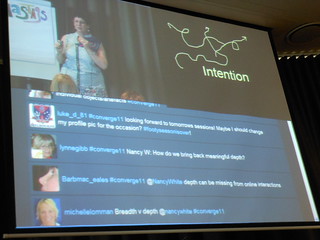 I've been meaning to share this resource for ages (and thanks to Jedd Bartlett for sharing this way back).
I've been meaning to share this resource for ages (and thanks to Jedd Bartlett for sharing this way back).You may be a fan of the backchannel at conferences, meetings, sessions that you are facilitating etc...or you may not be sure what a backchannel is. Educause (in this guide) provide a nice definition, and some of the benefits of backchannels:
Backchannel communication is a secondary conversation that takes place at the same time as a conference session, lecture, or instructor-led learning activity. This might involve students using a chat tool or Twitter to discuss a lecture as it is happening, and these background conversations are increasingly being brought into the foreground of lecture interaction.
Digital technologies allow background discussions—which have always been a component of classes, conferences, and presentations—to be brought out of the shadows and, perhaps, incorporated as a formal part of learning activities. Instructors and presenters alike should be aware of this dynamic and the opportunity it presents to add another dimension to learning.
Once you have read this guide, and maybe watched the two videos below, if it still sounds like something you would like to try then this tool (one of many that are out there) - Twijector - may useful. Twijector has:
- free and paid options,
- the ability to moderate certain words,
- an option to archive all tweets from your session or event,
- the ability to show photos, and
- you can tag
If you do give backchanneling a go, or have already done so, please share your experiences in the comments below. We'd love to hear from you :)
.
.



No comments:
Post a Comment